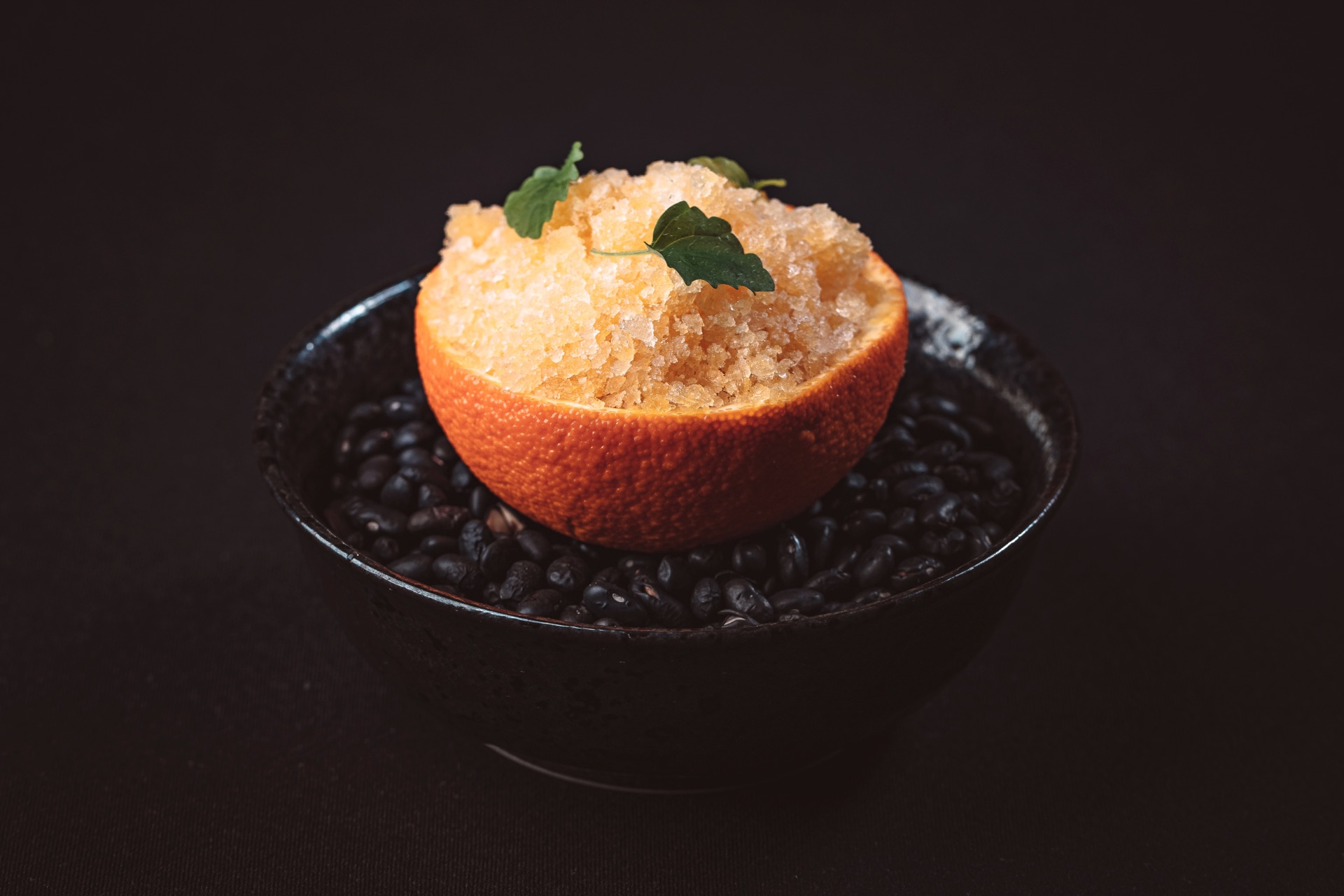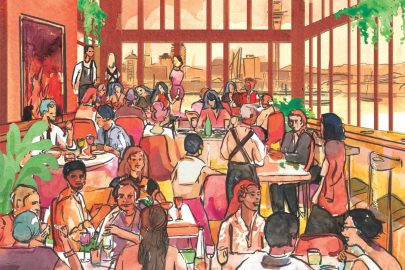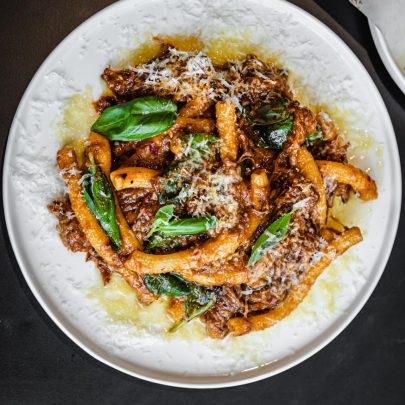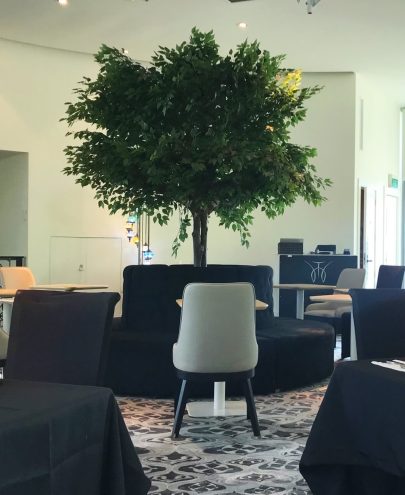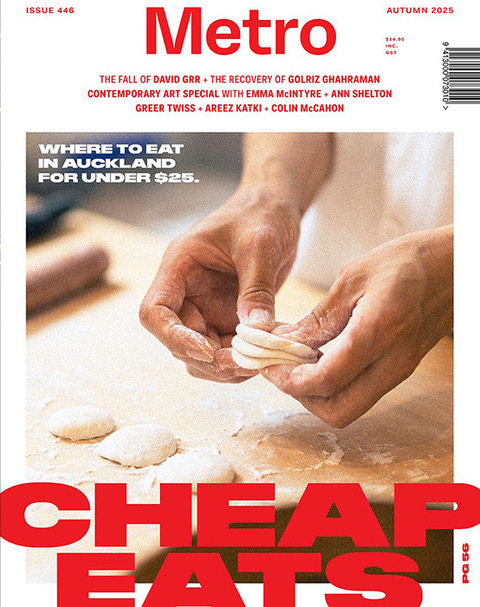Jan 30, 2024 Restaurants
The first dish was enveloped by a puff of foam. The bubbly cloud looked like soap suds, deflating as I carefully sifted through it to get to the scallops underneath. “Maple ponzu, yuzu koji, pumpkin and kombu,” I remember the chef listing off, though I didn’t know which of those ingredients went where. Foolishly, I decided to treat myself to a mouthful of foam. I nearly choked — it did not seem like an auspicious start. Once I actually got to the meat of it, though, it was a different story: fleshy seared scallops and ribbons of pumpkin, with a mingling of saltier flavours that seemed deliberately toned down, subtle. Foam aside, it served its purpose, to make me look forward to the rest.
It was a quiet night when we dined at Paris Butter in Herne Bay, with the other two tables being visitors from overseas. (That must be a key trade for the restaurant, considering the meal finished with a recommendations booklet of their favourite local spots.) Things have changed slightly since Paris Butter moved from bistro towards fine dining — the chairs, for one; those generic European bistro seats are gone — but the place manages to straddle the line, embracing refinement without seeming too stuffy. The lighting is just right, with a fusion of different styles smoothed over into elegance by the lush grey curtains and beehive chandeliers.
We were presented with our dishes by the server and chefs in a rotation, with the head chef Zennon Wijlens (who recently won Chef of the Year at Cuisine’s Good Food Awards) delivering a couple of them, including bread and butter on a tray with two different butters, a sourdough miso caramel example and a honey mustard. You can tell how serious a restaurant is by what kind of butter they serve. Another indication of seriousness: the snacks. Paris Butter gave us three: smoked trevally atop a meringue; chicken parfait in a tart shell; and their signature potato velouté, which I’ve had three times before and thought tasted the best on this visit. My favourite was the trevally, with its seafood saltiness disappearing gently into the soft white meringue.
Koji, a type of Japanese culture or ferment, is one of those things I know about but don’t completely understand — except that chefs love to use it in their cooking to dial up the savouriness. It plays a prominent role in seasonings, miso pastes, marinades, soy sauces, mirin and more. Koji was certainly mentioned a couple of times throughout the night, including in our second course, in which a circular scampi-filled pasta parcel lay almost perfectly, as if stamped, on top of the hāpuku, all smothered in a “koji beurre blanc”. I remember reading about a koji butter sauce in René Redzepi and David Zilber’s book The Noma Guide to Fermentation, for which they used a lacto-koji water emulsified with butter, to produce a more complex beurre blanc that hit deeper notes of sweet-salty-savoury. I’m not sure if the chefs at Paris Butter used that exact technique here, but I observed a similar result: a silky-yellow sauce that had a slightly funkier undertone — though, again, it was subtle.
I loved the dish. The hāpuku was cooked so well that it was still on the raw side of blush right in the middle. And instead of introducing too-punchy flavours into the actual dish, they poured pork hock consommé into a thimble on the side, designed to be slowly sipped in between bites of your fish. My dining partner called the broth “the most savoury thing” they’d ever tasted.
Sometimes I get disillusioned with ‘fine dining’ and its many quirks and fuss, its built-in flashiness and ego. I remember a few months ago, sitting in acclaimed Melbourne restaurant Vue de Monde, 55 floors up in the sky, thinking: what is the point of it all? But there is something seductive about the relationship in fine dining between experimentation, technique and just giving a damn. When all those things work together, producing a dish that makes you excited to eat it, that reconciles the bridge between expectation — set high by having to pay hundreds of dollars — and reality. It’s restorative of faith in the genre.
Not every dish at Paris Butter did that, though not a single dish was bad. I struggled with the sunflower seeds in the king crab — they added a slimy mealy texture, which knocked unpleasantly around in my mouth like socks spinning in a washing machine. This dish, too, came covered in a blanket of foam (this time broccoli) overlaid with delicate white blooms as if emulating a green meadow. Underneath, a vinegar gel offset the slight bitterness of broccoli — just a little bit, so as to not screw with the sweetness of the crab.
A note here about the non-alcoholic drinks pairing, which Paris Butter graciously offered me half of when I decided on a whim that I wanted it. (The pairing usually has to be pre-ordered, due to the preparation involved.) I love that it exists, and a lot of the drinks sound incredibly impressive — honeycomb! fermented herb paste! zero-alcohol tequila! a sprinkling of MSG! — but the taste was not quite there. It’s easy for drinks to be too thin and watery when you don’t have the full roundedness of alcohol to carry things through. I don’t say this to be discouraging — the intention is laudable, and I implore continual exploration in this category — but these drinks may need some more time in the workshop.
However, the main — duck, again hidden away by something (a recurring theme) — was delicious. This time, the cover was a nori cracker that had another layer of puffy grains, for crunch. Alongside was a dollop of parsnip and vanilla puree and burnt onion consommé. This was one of those combinations where it was hard to pick out one flavour over the others; they sort of blended in a pleasant way, acting as background noise to the pink duck and tasty skin.
Another highlight of the meal was the “crossover”, a palate cleanser served in a hollowed-out orange with orange granita, marmalade and honeycomb on the bottom. It was light and refreshing, though still with a bit of substance from the honeycomb, and offered a much-needed breather before the indulgence of dessert. When it came, the freeze-dried cheesecake (made using nitrogen!) was rich-rich-rich, even when mellowed out by a toasted-coconut sorbet.
One of the bite-sized petits fours that arrived after our dessert was a pork spring roll, wrapped in a crunchy wonton wrapper. It was a welcome swing back to the savoury, an intense hit that served as a counter to the previous heavy sweetness. I remember thinking, Oh weird, and then again, Oh, that makes sense. I think, at the heart of it, undergoing this thought process as you eat is the true pleasure of dining at this level. Oh, weird. Oh, that makes sense. Oh, weird. Oh, wait, that’s actually great! It’s realising that the chefs have fully considered the way diners will actually experience eating, from the moment a dish lands — the way the courses work together in unseen ways to convey purpose — that makes fine dining interesting.
Paris Butter ****
166 Jervois Rd, Herne Bay
09 376 5597
Hours
Mon — Sat 6 — 8.30pm
Fri 12pm onwards
Dinner Bill
Three courses $150pp
Six courses $195pp
Wine pairing $120–$220
Non-alcoholic pairing $65

